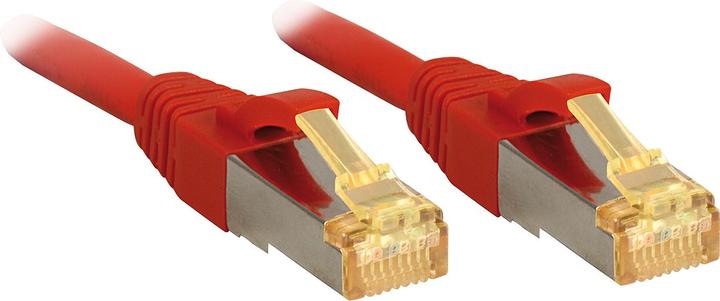
Lindy Network cable
S/FTP, CAT7, 20 m

Lindy Network cable
S/FTP, CAT7, 20 m
Hello JohannMilch, As you can see from the pictures, this product is not a ribbon cable.
With a length of 3m, you can usually use a simple cable; you only need a better one if you have a lot of interference.
Cat. 7 operates in a different (higher) bandwidth (MHz) than other (lower) categories. As a tendency, faster transmission speeds can also be achieved with higher categories. Cat.5 or Cat.6 are usually found in the "home network". The bottleneck in the home network is usually the internet connection itself (provider/internet subscription) - unless you are the lucky owner of a fibre optic connection where 1 Gbps (or more) symmetrical (up & down) is no problem. In this case, however, the other internal network components such as switches / APs / network cards would have to be checked and possibly replaced. However, such devices that can provide more than 1 Gbps are hardly affordable for private individuals and usually make little sense. S/FTP means that the cable(s) are fairly well shielded. On the one hand, the individual cables and the wire pairs are shielded, and on the other hand, the entire cable is shielded. Details @ https://de.wikipedia.org/wiki/Twisted-Pair-Kabel
Heyo, sadly the cable is not flat.
Yes, sure. This cable can transmit up to 10Gb/ per second.
You can do 10gbit easily even with a 6a cable, I'm not sure whether your upstream or downstream equipment is suitable.
A network cable cannot actually slow down work on the computer, so it is important to test what is slowing down: for example, saving data, in which case it is due to the memory capacity, or streaming content, in which case it is due to full memory. Online, i.e. when connected to the Internet, it may also be because too many people are travelling on the same channel. Tip: Disconnect the cable again and test what works. And then ask again!
Hello and thank you for your question. You need to use a UV-protected cable with S/FTP shielding. For example, cables for IP cameras exposed outdoors are ideal. Another good idea is to protect the cable with electrical installation sheathing, which is also UV-resistant. Some cable references, but please check with Digitec: Renkforce RJ45 RF-4538204 CAT 6a S/FTP 30.00 m Black suitable for outdoor use (S/FTP, CAT6a, 30 m) Primewire CAT.8 network cable, LAN cable, RJ-45, Ethernet, CAT 8 outdoor patch cable, IP66 40 Gbit/s S/FTP (PiMF, S/FTP, 15 m) Wirewin Outdoor patch cable (F/UTP, CAT5e, 20 m) We hope this has been helpful Yours faithfully
No, 10 Gbits is certainly correct.
hy anonymous. around 7-8 mm in total. Without breaking anything, finger lightly pressed 5 mm if necessary. Diameter in general according to google is 6mm. Greetings
Network is network.
Yes, which cable you use doesn't really matter.
Cat 6a can also deliver 10 Gbit. You don't necessarily need a cat 7 cable for this. However, it is recommended for the future. Another disappointment: you will never get the maximum speed because the connection is passive. The line is shared with several households. :D
This is a flexible cable.
By the way, there's a nice button in the specifications that says "Report incorrect data", so you could try that too ;)
According to the manufacturer, up to 600 MHz.
The specification Cat / Cat. (category) says something about the quality or properties of the cable and thus for which data rates you can use it. For home applications, a Cat 5 cable is completely sufficient, especially when it comes to the connection for a TV that can only handle 100 MB anyway. Since Cat 6 hardly makes a price difference, you can also use one of these. Cat 7 is not necessary. For home use, the flat cables are interesting because they are easier to lay. https://www.digitec.ch/de/s1/producttype/netzwerkkabel-294?p=1225%3A200221&pdo=1226-180%3A412&rsl=9-7%3A700%3A800&tagIds=7
This is a patch cable, simply 20m long.
What speed should be possible on the cable? In principle, a Cat. 5e, which already supports gigabit, is sufficient. Cat 6A or higher is recommended. Depending on how the cable is to be shielded against environmental influences, this is another important factor in the decision.
Cat 7 can handle up to 10Gb.
Yes, this is a category 7 cable and could therefore transmit up to 10 Gbit/s.
Yes, this cable can handle 1 Gb/s. Cat.7 is suitable for up to 10 Gb/s.
30 of 55 questions